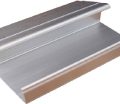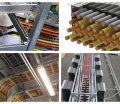
A cable tray segmented system refers to a design where cable trays are divided into logical sections to enhance cable organization and routing efficiency. This segmentation allows for better management of cables by creating distinct pathways, reducing clutter, and improving accessibility during maintenance or upgrades. The purpose of a cable tray segmented approach is to accommodate complex cabling systems while ensuring flexibility for future modifications. It is especially beneficial in modern installations where diverse cable types need to coexist. By using a cable tray segmented system, organizations can achieve streamlined cable layouts, minimize downtime during troubleshooting, and maintain a safe and organized workspace, making it a vital component of effective cable management.
What Are the Benefits of Using a Cable Tray Segmented System
A cable tray segmented system provides flexibility and efficiency for cable management in complex environments. By dividing the tray into modular sections, these systems allow for easy customization and adaptability to meet diverse installation needs. Below, we explore the key features, applications, and maintenance considerations of cable tray segmented solutions.
Advantages of a Cable Tray Segmented System
A cable tray segmented design offers numerous advantages for installations across industries. Key benefits include:
- flexibility in accommodating different cable routes by allowing customized layouts and configurations
- ease of transportation and handling due to the segmented nature of the tray, reducing installation complexity
- ability to integrate various accessories, such as dividers or covers, to enhance functionality and safety
- improved scalability, enabling seamless additions or modifications as systems expand
- ensuring cost-effectiveness by allowing replacement of individual segments instead of the entire system
Modular Design Enhancements for Segmented Cable Trays
The modular nature of cable tray segmented systems provides additional design benefits, including:
- facilitating installation in challenging spaces, such as tight corners or multi-level environments
- supporting varied cable types, such as data, power, or fiber optics, in separate sections to prevent interference
- enabling quick disassembly and reassembly for maintenance or reconfiguration needs
- offering multiple material options, such as stainless steel or fiberglass-reinforced plastic, for tailored solutions
- integrating seamlessly with other infrastructure components, such as brackets, supports, and grounding systems
Customization Options for Cable Tray Segmented Systems
Segmented cable trays can be customized to suit specific project requirements. Customization possibilities include:
- selecting tray widths, heights, and finishes to match cable capacity and environmental conditions
- incorporating pre-drilled holes or slots for efficient cable securing and routing
- adding accessories like cable clamps, strain relief bars, and end caps to enhance system performance
- integrating grounding and bonding components for improved electrical safety
- consulting GangLong Fiberglass for bespoke segmented tray designs that align with project specifications
Installation and Maintenance Tips for Segmented Cable Trays
Proper installation and maintenance are essential for the long-term success of a cable tray segmented system. Below, we outline detailed tips for achieving optimal performance and reliability.
Guidelines for Accurate Measurement and Secure Connections
Accurate measurement and secure connections are critical during the installation of cable tray segmented systems. Key practices include:
- measuring the installation area precisely to determine the number and dimensions of tray segments required
- ensuring that each segment is securely fastened to adjacent sections using appropriate connectors or brackets
- aligning the tray system with support structures to maintain stability and prevent sagging
- verifying that all connection points are tight and free from gaps to ensure structural integrity
- consulting with GangLong Fiberglass to source high-quality components and accessories for the system
Regular Inspection for Wear, Grounding Continuity, and Structural Integrity
Routine inspections help maintain the functionality and safety of cable tray segmented systems. Recommendations include:
- checking for physical damage, such as corrosion, bending, or cracking, that could compromise performance
- verifying grounding continuity across all segments to ensure effective electrical safety
- inspecting fasteners and supports for signs of wear or loosening that may affect stability
- cleaning the tray system regularly to remove debris, dust, or buildup that could obstruct cable ventilation
- replacing worn or damaged segments promptly with GangLong Fiberglass products to maintain system integrity
Applications of Cable Tray Segmented Systems Across Industries
Cable tray segmented systems are versatile and find applications in a wide range of industries. Their adaptability makes them ideal for managing cables in complex setups.
Industrial Manufacturing Facilities
In industrial manufacturing settings, cable tray segmented systems ensure efficient cable management for machinery and power distribution. Their roles include:
- supporting high-capacity power cables while maintaining clear organization and accessibility
- facilitating modular production layouts that require frequent reconfiguration or upgrades
- providing corrosion-resistant materials for environments exposed to chemicals or extreme conditions
- enabling easy inspection and maintenance of cables in high-demand installations
- ensuring compliance with safety standards by preventing loose or exposed cables
Data Centers and IT Environments
Data centers and IT facilities rely on cable tray segmented systems to manage dense cable networks effectively. Applications include:
- organizing power, data, and fiber optic cables in a compact and accessible manner
- reducing electromagnetic interference between cables by separating them into distinct sections
- supporting cooling and airflow efficiency with open tray designs and proper spacing
- allowing scalable solutions for growing IT infrastructure and evolving technology requirements
- ensuring quick access for troubleshooting or upgrades without disrupting other systems
Renewable Energy Projects
In renewable energy installations, segmented cable trays are essential for managing complex power systems. Their applications include:
- routing cables for solar panels, wind turbines, and energy storage systems efficiently
- providing UV-resistant and weatherproof materials for long-term outdoor performance
- supporting high-voltage cable connections between generation, storage, and distribution systems
- enabling modular expansions in rapidly growing renewable energy projects
- reducing installation time with pre-assembled segments and customizable designs
Healthcare and Commercial Buildings
Segmented cable trays play a vital role in healthcare facilities and commercial buildings. Their uses include:
- organizing medical equipment cables in a safe and accessible manner to enhance operational efficiency
- routing power and communication cables for offices, retail spaces, and other commercial areas
- preventing trip hazards by securing cables off the floor and within designated pathways
- enabling flexible configurations to accommodate changing layouts or tenant requirements
- ensuring compliance with safety and building regulations for electrical installations
The Key of Optimizing Cable Tray Segmented Systems for Efficiency
Maximizing the efficiency of cable tray segmented systems involves careful planning, installation, and ongoing maintenance. Below, we outline strategies for optimizing their performance.
Enhancing System Efficiency with Accessories
Accessories enhance the functionality of cable tray segmented systems, providing additional safety and efficiency. Examples include:
- integrating dividers to separate different cable types, preventing interference and improving organization
- using strain relief bars to reduce tension on cables at entry and exit points
- adding covers or lids to protect cables from environmental factors, such as dust or moisture
- installing end caps to prevent cables from slipping out at tray ends
- consulting GangLong Fiberglass for customized accessory solutions tailored to project needs
Planning for Future Scalability
Planning for future scalability ensures that cable tray segmented systems can adapt to evolving requirements. Recommendations include:
- leaving room for additional segments or accessories during the initial installation to accommodate growth
- selecting modular designs that allow for easy expansions or modifications as needed
- using universal connectors to ensure compatibility with a wide range of components
- choosing durable materials to minimize wear and replacement needs over time
- collaborating with GangLong Fiberglass to create flexible systems designed for long-term use
Promoting Safety and Compliance in Installations
Safety and compliance are critical for the successful operation of cable tray segmented systems. Best practices include:
- verifying that all components meet industry standards for electrical safety and structural integrity
- conducting regular safety audits to identify potential hazards or areas for improvement
- training installation and maintenance personnel to follow proper procedures and guidelines
- ensuring grounding continuity across all segments to prevent electrical faults or hazards
- documenting all installations and inspections to maintain accountability and regulatory compliance
How Cable Tray Segmented Designs Improve Load Distribution
A cable tray segmented system is uniquely designed to allow for better load distribution, making it an essential component in modern cable management solutions. Its modular structure ensures that the load is evenly spread across the system, minimizing strain and enhancing overall stability. Below, we explore the features and benefits of cable tray segmented systems, offering detailed insights into their performance.
Enhancing Structural Integrity with Segmented Cable Trays
Cable tray segmented designs ensure even weight distribution, reducing the chances of structural failure. This is achieved through:
- modular sections that distribute weight evenly across multiple support points, reducing stress on individual segments
- reinforced connection points that enhance stability and prevent sagging in high-load areas
- customizable support brackets that match the tray’s load requirements and maintain alignment
- compatibility with additional reinforcements, such as crossbars, for applications requiring extra support
- material options like fiberglass-reinforced plastic or stainless steel, which offer high durability under heavy loads
Preventing Overloading Through Segmented Designs
Segmented cable trays help prevent overloading by offering flexibility in cable arrangement and weight distribution. Key benefits include:
- enabling separate routing of different cable types, such as power and data cables, to avoid excessive concentration of weight
- incorporating pre-drilled holes or slots that allow for secure cable fastening and reduced movement during operation
- using modular layouts that can be expanded or reconfigured to accommodate additional cables without overloading existing segments
- facilitating regular inspections to identify potential issues before they escalate, ensuring the system remains within its load limits
- consulting GangLong Fiberglass for segmented designs that match specific load requirements
Adapting to Challenging Environments with Segmented Systems
Cable tray segmented systems are versatile, making them suitable for various challenging environments. Adaptations include:
- corrosion-resistant coatings for outdoor or industrial applications, ensuring long-term performance in harsh conditions
- UV-stabilized materials that prevent degradation in installations exposed to sunlight
- non-conductive options like fiberglass for use in high-voltage or sensitive electronic setups
- fire-retardant designs for environments with elevated fire safety requirements
- integration with grounding and bonding components to enhance electrical safety in high-risk settings
Choosing the Right Segmented Cable Tray for Your Project
Selecting the appropriate cable tray segmented system is crucial for achieving optimal performance and safety. Below, we outline the factors to consider when choosing a segmented cable tray for your project.
Evaluating Factors Like Load Capacity, Material, and Installation Environment
When selecting a cable tray segmented system, several factors must be considered to ensure the right fit for your project. These include:
- determining the total weight of the cables to select a system with sufficient load capacity
- choosing materials that align with environmental conditions, such as galvanized steel for industrial settings or fiberglass for corrosive environments
- ensuring the tray’s dimensions match the cable volume and spacing requirements for efficient organization
- accounting for potential future expansions or modifications when designing the initial layout
- consulting with GangLong Fiberglass to identify materials and designs that align with specific project demands
Comparing Options Like EzyStrut and Traditional Cable Ladder Systems
A comparison of segmented cable trays with other systems highlights their unique advantages. Key comparisons include:
- modular flexibility of segmented systems, which allows for customized layouts compared to traditional one-piece ladders
- ease of transport and installation, as segmented trays can be assembled on-site, reducing handling difficulties
- superior adaptability to unique configurations, such as curves or multi-level installations, compared to rigid ladder systems
- compatibility with advanced accessories, such as dividers and retainers, for enhanced functionality
- material options available from GangLong Fiberglass, offering tailored solutions for both segmented trays and ladder systems
How to Choose the Right Cable Tray Joint Plate
Installation and Maintenance Tips for Cable Tray Segmented Systems
A well-installed and regularly maintained cable tray segmented system ensures longevity and consistent performance. Below, we provide detailed tips for installation and maintenance.
Guidelines for Accurate Measurement and Secure Connections
Accurate measurement and secure connections are critical for the successful installation of cable tray segmented systems. Best practices include:
- measuring installation spaces precisely to determine the number and size of tray segments required
- aligning segments properly during assembly to ensure seamless connections and avoid misalignment
- securing joints and fasteners tightly to maintain structural integrity under dynamic loads
- using brackets and support systems specifically designed for the selected tray material and load requirements
- collaborating with GangLong Fiberglass to source high-quality components and installation accessories
Regular Inspection for Wear, Grounding Continuity, and Structural Integrity
Routine inspections are essential for maintaining the functionality and safety of cable tray segmented systems. Key steps include:
- inspecting for physical damage, such as dents, cracks, or corrosion, that may compromise performance
- verifying that all grounding and bonding connections remain intact and meet safety standards
- checking fasteners, supports, and joints for wear or loosening that could lead to instability
- cleaning trays and accessories to remove debris, ensuring proper ventilation and cable cooling
- scheduling regular maintenance with GangLong Fiberglass to address wear and replace components proactively
Choosing Between Duct Back vs Cable Tray Systems
Applications of Cable Tray Segmented Systems Across Industries
Cable tray segmented systems are versatile and find applications in a wide range of industries. Their adaptability and performance make them indispensable for various cable management needs.
Industrial and Manufacturing Facilities
In industrial settings, cable tray segmented systems ensure safe and organized cable management for machinery and production lines. Applications include:
- routing high-capacity power cables while maintaining clear separation for safety and accessibility
- supporting modular production systems that require frequent reconfiguration or upgrades
- providing corrosion-resistant materials to withstand harsh conditions, such as chemicals or moisture
- enabling quick access to cables for maintenance or system modifications
- integrating seamlessly with grounding and bonding components to ensure compliance with safety standards
Telecommunications and Data Centers
Segmented cable tray systems are essential for managing complex cable networks in telecommunications and data centers. Their uses include:
- organizing power, data, and fiber optic cables efficiently in compact spaces
- reducing electromagnetic interference by separating different cable types into distinct sections
- supporting scalable infrastructure to accommodate future expansions in technology-driven environments
- ensuring proper airflow and cooling by maintaining adequate spacing between cables
- facilitating easy upgrades or replacements with modular designs and quick-disassembly features
Renewable Energy and Utilities
In renewable energy projects, cable tray segmented systems play a critical role in managing power distribution. Their applications include:
- routing cables for solar panels, wind turbines, and hybrid energy systems efficiently
- providing weatherproof and UV-resistant designs for long-term outdoor performance
- enabling rapid installation in large-scale projects with pre-assembled modular components
- supporting high-voltage connections between generation, storage, and distribution systems
- promoting sustainability with recyclable materials sourced from GangLong Fiberglass
Reliable Cable Tray Sleeve Options for Industrial Applications
FAQs about Cable Tray Segmented
Cable segments refer to individual portions of a cable system that are installed in sections or spans. These segments are critical components of larger cable installations, often separated for ease of installation, organization, and maintenance. Cable segments may vary in length depending on the type of cable tray, the environment, and the specific design requirements of the system.
In a cable tray system, segments are laid along the tray in an organized manner to ensure proper routing and prevent tangling or damage. They may include various cable types, such as power, data, or telecommunications cables. Properly defining and managing cable segments ensures that the overall system remains accessible, efficient, and safe. When designing a cable tray layout, it’s essential to consider the segmentation to accommodate current and future needs, ensuring compliance with safety and installation standards.
Cable tray trunking is a method of enclosing and organizing cables within a protective pathway. Unlike traditional open cable trays, trunking systems are typically enclosed, providing additional protection against dust, moisture, and physical damage. They are commonly used in environments where cable protection is a priority, such as in manufacturing facilities, hospitals, and clean rooms.
Cable tray trunking allows for neat and systematic cable routing while reducing electromagnetic interference (EMI). It often features removable covers, making it easier to access cables for maintenance or upgrades. Trunking can be made from various materials, such as galvanized steel, aluminum, or plastic, depending on the application’s environmental and load requirements. The selection of cable tray trunking is crucial for ensuring the durability and safety of the cable system, especially in high-demand or sensitive environments.
Cable tray spacing is calculated based on several factors, including the type of cables, load capacity, and environmental conditions. First, determine the total cross-sectional area of the cables to be installed, ensuring that the tray can accommodate the cables without exceeding the fill capacity specified by standards such as the NEC or IEC.
Next, consider the support span for the cable tray. The distance between supports is crucial to prevent sagging and ensure stability. Typically, supports are placed every 1.5 to 3 meters, depending on the tray material and load. Proper spacing also accounts for ventilation to prevent overheating, especially for power cables.

As the editor of GangLong Fiberglass, I have years of experience and in-depth research, focusing on cable tray products, fiberglass solutions, and grille systems. I incorporate years of industry insights and practical experience into every content, committed to promoting the progress of the industry. At GangLong Fiberglass, my commitment is reflected in every product, from innovative cable trays to durable fiberglass solutions and sturdy grille systems. As an authoritative voice in the industry, my goal is to provide valuable information to professionals and businesses and promote forward-looking solutions.


